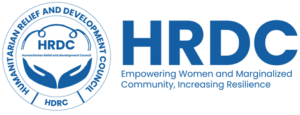HRDC believe that access to WASH, in specific safe water, adequate sanitation, and proper hygiene education, can reduce illness and death, and also impact poverty reduction and socio-economic development. The main objective of HRDC’s WASH program is to respond to the water crisis by increasing local awareness of the WASH situation while further encouraging mobilization around the emergency needs of the most vulnerable communities. Water 663 million people worldwide live without access to clean water. This is more than a fact; this is a daily truth. 1 child dies every 90 seconds because of a diarrheal disease caused by contaminated water and poor sanitation. This is more than the most dangerous disease in the world. $260 Billion annually of total global economic losses related to insufficient water supply and sanitation. Reduced access to water is the harsh reality for millions worldwide, and an equally unfortunate 2.4 billion people live without access to adequate sanitation. Every day, millions of women and girls walk for miles on end just to fetch and carry water, creating a cycle of inequality. The daily pressure of these factors makes it impossible to develop one’s full potential or even dream of a better life. Water-related illness has been estimated to cause the loss of 443 million school days each year, the equivalent of 615,000 kids missing all 4 years of high school.
HRDC enhances access to clean and potable water to households and their livestock by promoting rainwater harvesting technologies to adapt to climate change through the establishment of underground water harvesting tanks. Also through the drilling of boreholes, rehabilitation, and improvement of water pans and shallow wells.
Sanitation
Sanitation is the intervention to reduce human exposure to disease by providing a clean environment which is done by the provision of toilets. 946 million people go in the open, known as “open defecation”. While progress has been made to improve access to sanitation in some parts of the world, millions of people in poor and rural areas have been left behind. Currently, 1 in 7 people, of 946 million people, practice open defecation. Of those who do, 9 out of 10 live in rural areas.
Open defecation is when people go out in fields, forests, open bodies of water, or other open spaces rather than using a toilet. It is incredibly dangerous, as contact with human waste can cause diseases such as cholera, typhoid, hepatitis, polio, diarrhea, worm infestation, and undernutrition. One of the biggest challenges to ending open defecation is not just providing clean and safe toilets, but changing the behavior of entire communities. HRDC works on stopping open defecation through awareness creation, sharing information, and urging behavior change in an effort to bridge the gap between building toilets and their correct use. Worldwide, there are more people who own cell phones than have access to toilets.
Hygiene
HRDC aims at promoting communities on good hygiene practices like hand washing after going to the toilet and before any contact with food, especially for children to prevent disease. Something as simple as hand washing can save lives.
Washing hands with soap at critical times, like after going to the toilet or before eating, can have a significant impact on children’s health. Good sanitation practices reduce the incidence of diseases such as pneumonia, trachoma, scabies, skin and eye infections, and diarrhea-related diseases like cholera and dysentery. Research shows that regular handwashing with soap can reduce the number of incidents of diarrhea, a disease that can be deadly for children, by around 50 percent. The key to enhancing hygiene practices is to promote behavioral change within schools and communities. HRDC leads a number of campaigns aimed at improving, informing, and educating communities in the ASAL areas about good hygiene routines. Keeping animals at distance from the household and particularly the kitchen of a family, as well as disposing of garbage in a safe place are other important hygiene messages in order to avoid dirt contact. Training and communication are important components of promoting hygiene; however, training alone does not necessarily result in improved practices. Promoting behavior change is a gradual process that involves working closely with communities, studying their beliefs, defining motivation ways, designing appropriate communication tools, and finally, encouraging practical steps towards positive performance.

